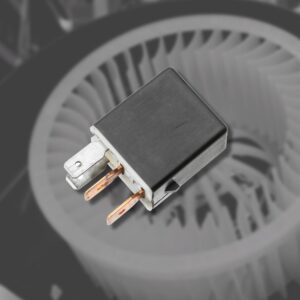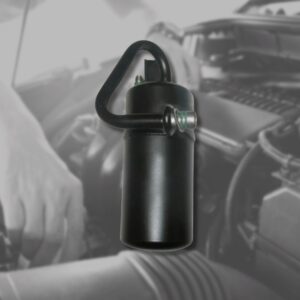Your ride’s hood protects your engine from debris and other elements while also providing access to the engine during maintenance and repair. The hood latch assembly makes it possible for your hood to do that.
How Does a Hood Latch Work?
A hood latch acts as a fastener that keeps the hood shut. The hood latch mechanism also opens the hood a couple of inches once you pull the release lever that’s usually located below your dashboard.
The lever or release handle is usually connected to a cable that triggers the actuator to disengage the latch, allowing the hood to open by a few inches.
After the hood is initially “popped,” as the common lingo states, the hood opens just an inch or so, providing access to the secondary safety latch that must be released by hand before the hood can be fully raised. This safety latch is required by U.S. federal law.
If you don’t know where the secondary latch is, it can be challenging to find it. Sometimes, the secondary hood latch will have a yellow element that makes it easy to spot.
What Are the Reasons Why Hood Latches Fail?

Like any other mechanism in your vehicle, hood latches can also fail. Here are the common reasons why it happens:
Collisions
Road accidents, especially front-end collisions, can damage your hood latch. If your vehicle was recently involved in an accident, whether it’s major or minor, make sure you check your hood latch along with other parts of your vehicle.
A hood latch can also be accidentally damaged if a person working on the car with the hood open drops something on the latch, so that it’s bent.
Rust
Rust and corrosion can cause the hood latch to fail. This is more of a problem in northern climates where cars rust due to road salt. You can find your latch hidden inside your hood, but it doesn’t mean it’s safe from moisture and the elements. For example, a hood latch that’s located behind the grille can be vulnerable to corrosion because of air, moisture, and salt spray.
Misadjustment
If your hood opens partially, you might be dealing with a misadjusted hood latch. A misadjusted latch can shift from where it’s bolted, so the hood will only open partially.
Typically, the holes in the hood latch mechanism are much larger than the bolts. Their holes and the bolts will have a large slightly cupped washer that’s part of the bolt with barbs around the outer edge of the washer facing the surface of the latch mount. A misadjusted hood latch bracket can make it difficult for you to close your hood.
Normal Wear and Tear
Although hood latches can last the life of your vehicle, it isn’t uncommon for them to wear out. Around 10% of the vehicles more than 10 years old will have some kind of hood latch malfunction. Frequently opening your hood, dirt contamination, and more factors can cause hood latch failure. If you own an old vehicle and suspect a hood latch problem, get it checked right away to avoid major problems down the road.

Frozen or Damaged Hood Release Cable
Aside from a bad latch, there are other reasons why a hood may become difficult to open. The hood release cable or a broken cable mount under the dash are two of the most common failures that cause problems opening the hood. When replacing the cable (it can be a tough job), make sure that the grommet is firmly in place where the hood cable passes through the bulkhead into the engine compartment. If you don’t seat the grommet, you’ll have a bad water leak that’ll wet the floor of the car when it rains.
How to Open a Stuck Hood
Here are some tricks you can try if you need to open a car hood manually.
If there’s another person with you, let them hold the release lever while you press down on the hood. This can usually trigger a stuck latch to disengage. It doesn’t work a hundred percent of the time, but it’s surely worth a try. If this becomes necessary, adjust and lubricate the latch.
If you’re a DIYer, you can attempt to disengage the latch manually. Lift your vehicle using a jack and make sure it’s properly supported by jack stands. Slide underneath your car and locate your latch. Using a pry bar, reach for the latch and slide it. Your hood should pop open by then. Of course, you might not be able to access the latch this way, so this method isn’t 100%.
These are only temporary measures to open a stuck car hood in case of an emergency. It’s more advisable to leave a hood stuck closed than open. The best thing to do is take a trip to an auto repair shop and have a professional take care of the problem.
If you happen to try and fix the hood yourself without properly handling the repair, the safety latch might not work and the hood could fly up going down the road. This can break the windshield and make driving extremely dangerous if you’re on the road.
Is It Safe to Drive with a Bad Hood Latch?
You can technically drive your car even if your hood latch broke or it malfunctioned. However, it’s not recommended if the hood is stuck open. Remember that your car hood protects the engine from the elements. If your hood isn’t sealed properly, contaminants can damage crucial components.

How to Find the Right Hood Latch for Your Ride
Hood latches may seem like simple mechanisms, but that doesn’t mean you can just get any replacement assembly for your vehicle. Here are some of the things to consider when getting a hood latch.
Type
Hood latches come in different types. Vertical hood latches, for instance, are installed upright while horizontal latches are parallelly flat. If you’re not sure which type of hood latch you need, you can consult your owner’s manual or talk to a trusted mechanic.
Material
Many hood latches are made of stainless steel, which makes them durable. Some have additional plating to shield them from rust and other forms of damage.
Aside from type and material, there are other things to consider when buying a hood latch. For example, you might prefer a specific brand or you might have a price range in mind. There are many top-notch aftermarket hood latches out there, so you’ll surely find a replacement in no time.
The components inside your hood all play crucial roles in the operation of your vehicle. That’s why it’s important to keep them protected from anything that can cause them to fail.
Aside from your hood latch, make sure that other components like the grille and the hood itself are checked from time to time. Having these inspected during maintenance checks can help prolong the life of your engine and other nearby components.
How to Get a Quality Replacement Hood Latch
A faulty hood latch can be an inconvenience, to say the least. Not being able to open your hood can cause issues if you need to check your engine, and not being able to close your hood means not being able to keep the hood down while driving. If you need a replacement hood latch, you can turn to CarParts.com.
The CarParts.com website is designed to be easy-to-navigate. It takes only a few quick clicks to browse our catalog and place your order. We have a wide selection of aftermarket parts to choose from, all at different price points to suit your budget. Use our vehicle selector and enter your vehicle’s year, make, and model to ensure you only get parts that fit. We’ll have your parts delivered to your door in as fast as two business days, thanks to our strategically located warehouses.
Don’t wait for your car hood to spring up in the middle of a drive. Place your order for a new hood latch at CarParts.com today.
Any information provided on this Website is for informational purposes only and is not intended to replace consultation with a professional mechanic. The accuracy and timeliness of the information may change from the time of publication.






























